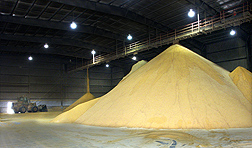Kitty Litter: Potential New Assignment
for Leftover Dried Distiller’s Grains
Sometimes ARS research really is the cat’s meow.
Plant physiologist Steve Vaughn and colleagues have shown that dried distiller’s grains, or DDGs—the leftovers after corn kernels are used to produce ethanol—can be processed further to make a promising, nearly 100-percent-biodegradable kitty litter.
With further testing, the litter may prove to be a more Earth-friendly choice than the popular but nonbiodegradable clay-based litters that today end up, for the most part, in landfills. At the same time, the DDG-based litter may provide a new and perhaps higher value market for the tons of DDGs that ethanol refineries primarily market as a cattle-feed ingredient.
In their research, Vaughn’s group tested what are known as “x-DDGs.” These are DDGs that, after being used for ethanol production, are treated with one or more solvents to extract any potentially useful natural compounds that remain.
The laboratory experiments yielded a suggested formulation composed of the x-DDGs and three other compounds: glycerol, to prevent the litter from forming dust particles when poured—or pawed; guar gum, to help the litter clump easily when wet; and a very small amount of copper sulfate, for odor control. The resulting litter is highly moisture absorbent, forms strong clumps that don’t crumble when scooped from the litter box, and provides significant odor control, says Vaughn. He’s based at the National Center for Agricultural Utilization Research in Peoria, Illinois.
The idea of using corn or other grains as the basis of an environmentally sound cat litter isn’t new. But the Peoria team may be the first to as extensively study the potential of x-DDGs as the primary component of a litter and to make their results publicly available. Their peer-reviewed scientific article appeared in a 2012 issue of Industrial Crops and Products.
America has a continuing demand for kitty litter. Today, there are more than 95 million pet cats in this country, according to the American Pet Products Association. Most of these kitties are kept indoors, creating a need for about 1.18 million tons of cat litter every year. “Clumping” litters, made from sodium bentonite clay, are among the most popular, but they are not biodegradable.
Though the economics of producing an x-DDG-based litter weren’t studied, they would likely depend on the profitability of compounds extracted from DDGs. The team tested both DDGs and x-DDGs and found that x-DDGs were the better choice for litterbox use.
The tests of x-DDGs are part of ongoing studies at the Peoria research center to develop new uses for crops and their byproducts. Vaughn did the work with chemists Mark A. Berhow and Jill K. Winkler-Moser at Peoria and Edward Lee of Summit Seed, Inc., Manteno, Illinois.—By Marcia Wood, Agricultural Research Service Information Staff.
This research is part of Quality and Utilization of Agricultural Products, an ARS national program (#306) described at www.nps.ars.usda.gov.
Steven F. Vaughn is with the USDA-ARS National Center for Agricultural Utilization Research, 1815 N. University St., Peoria, IL 61604; (309) 681-6344.
"Kitty Litter: Potential New Assignment for Leftover Dried Distiller’s Grains" was published in the October 2013 issue of Agricultural Research magazine.







